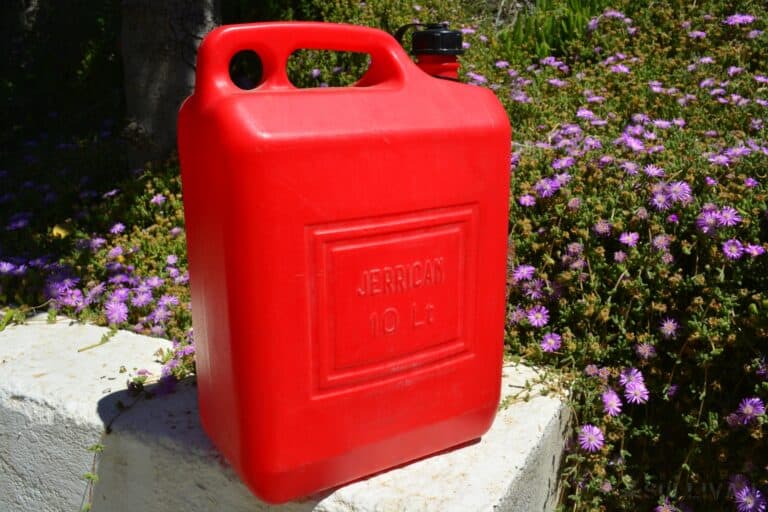Whether you’re looking to stock up your car with extra fuel, or run a gas-powered generator, gasoline is an essential item for any prepper. But, storing fuel is tricky because gas can go bad and cause problems for your engine. Just how long does gasoline last, you might ask?
Properly stored gasoline can last between 3 and 6 months. With a stabilizer, gasoline can sit for up to 3 years without going bad.

The shelf life of gas varies based on the type of gas you’re using, what you’re storing it in (e.g., a gas tank, plastic container, or jerry can), and if you’re using a stabilizer.
To ensure that you always have fuel when you need it most, here’s our guide to everything you need to know about the shelf life of gasoline. Up next, I’ll discuss precisely how long it takes for gas to go bad and how you can tell if your gas stockpile is past its expiration date.
DISCLAIMER: Gas is a flammable substance and storing large quantities of it can be dangerous.
In many locations, gas storage is regulated by law, so check in with your town supervisor or local fire department about the rules and regulations in your area before you try to stockpile large amounts of fuel.
Does Gasoline Go Bad?
Ironically, even though gasoline is made from fossil fuels, which have been on Earth for millions of years, it does “go bad” surprisingly quickly. Gasoline is incredibly volatile, which means that it separates and vaporizes when it sits for too long.
When gas separates and vaporizes, it loses combustibility. As a result, engines using old gas are significantly less efficient, which can cause problems for them that we’ll discuss in a bit.
How Long Does It Take For Gas To Go Bad?
The thought that gasoline sitting in your car or in that jerry can you bought a while back could do some damage to your engine is a scary one, indeed. However, the key is knowing what the shelf life of gasoline is so you can ensure that you always have quality gas on hand.
Precisely how long your gas will last in storage depends on the type of gasoline that you’re using. Here’s what you need to know:
Ethanol-blended Gasoline
The vast majority of gasoline sold in North America (and around the world, for that matter) is “ethanol-blended” gas, often called just ethanol gas. In fact, most gasoline in the US is what’s known as “E10,” which means that it is actually 10% ethanol.
Why does this matter? Well, ethanol is “hydrophilic” or “water-loving,” so it likes to absorb water vapor that’s sitting in the air around it. Water vapor naturally forms inside containers from condensation, especially as temperatures fluctuate throughout the day.
If this happens, the gas absorbs the water, which causes the fuel to separate into layers of ethanol and gas. As a result of this water contamination, the gas becomes less combustible and “goes bad.”
For the most part, E10 ethanol-blended gasoline will last only about 3 months. However, the higher the ethanol content, the quicker the gas will go bad. So, E20 (20% ethanol) and E25 (25% ethanol) can go bad after just 1 month of sitting in storage.
Pure Gasoline (Ethanol-Free Gasoline)
While most gas that you’ll find in the US is ethanol-blended, it is possible to find pure gasoline, or “ethanol-free gasoline,” in the country.
It’s generally quite easy to find pure gas in marinas as it’s a popular fuel for use in marine gas engines, though there are some roadside gas stations that will also sell you ethanol-free fuel, too.
Plus, pure gas can last upwards of 6 months if stored properly in a sealed container. This is because pure gas is actually “hydrophobic” or “water-hating,” so it doesn’t absorb water as well as ethanol-blended gas does, slowing down the separation process.
Shelf Life Of Gas In Different Containers
What you store gas in is just as important to its shelf life as the type of gas you’re using. In fact, properly stored, ethanol-blended gas can often last longer than improperly stored pure gas. Here’s how different types of containers affect the shelf life of your gas:
Inside A Gas Tank
It turns out that a gas tank is among the worst places to store your gas. Ethanol-blended gas will start to degrade inside your gas tank within just 1 month. Pure gas will sit well for slightly longer, but not by much, especially in humid locales.
In A Plastic Container/Jerry Can
A sealed, air-tight plastic container or jerry can is the best place to store gas outside of a dedicated gas storage tank. When kept in a cool, low-oxygen and low-humidity environment, ethanol-blended gas can last up to 3 months while pure gas can stay good for up to 6 months.
How Long Does Gasoline Last With A Stabilizer?
In reality, 3-6 months isn’t a particularly long shelf life for gas. Thankfully, there are ways to increase the shelf life of gasoline, namely, with a stabilizer.
Stabilizers, such as STA-BIL, slow down the oxidation and separation process of gasoline, giving it a longer shelf-life. Precisely how long gas lasts with a stabilizer depends on three things: (1) the type of fuel you have; (2) the type of stabilizer you use; and (3) what you store it in.
However, you can usually get at least 1 year of shelf-life out of a single bottle of stabilizer and sometimes up to 3 years of storage time. That being said, adding a stabilizer to a container of old gas won’t magically restore it to full efficiency.
Rather, a stabilizer is most effective when added to freshly pumped gas that you plan to keep properly stored in a container for many months.
You Can Buy Gasoline Blended for Extra-long Storage Life
For daily driving or known short-term storage, any common gasoline you get from your local station will do fine.
But if you really want gas that can withstand a long time in storage without spoiling you should definitely consider looking for a dealer that sells specially blended long-life gasoline.
These gasolines typically increase reliable storage life by a huge margin, and are available in leaded and unleaded formulas with other specific characteristics for various vehicles or uses.
For stockpiling, this stuff is tops, and can save you a ton of time and grief over trying to manage the regular stuff.
Sure, you can buy some regular gas and pop a bottle of fuel stabilizer in it before hoping for the best, but chances are it is still going to turn into bad gas in about a year’s time.
But the long-life gasoline we’re talking about is a blend that is manufactured for just such a task, and in a range of different octanes. Some blends are even capable of sitting for two years with no issues or degradation so long as you can keep moisture at bay.
Bear in mind that this storage capability is as-is, straight from the pump without any additives, extra stabilizers, or stuff like that.
Now, there is a small catch: This isn’t the kind of gasoline that you usually see advertised (or available!) at convenient gas stations or other usual sellers when driving around town. You’ll need to search it out.
Luckily, in most places, it’s not particularly difficult to come by, either. Run a search online for gasoline suppliers in your region with the words “long life gas” or “long storage life gas” and you should locate at least one.
Expect that you’ll probably have to go out of your way to get it, and expect that there may be a minimum purchase quantity, but I can’t emphasize enough how beneficial this will be for streamlining your prepping efforts and easing the chore of rotation.
For best results, store this long-term storage gas in a high-quality, ventless container to minimize contamination.
What Happens If You Use Old Gasoline?
All this talk about gasoline “going bad” is enough to make anyone wonder what actually happens if you use old gas.
Will putting old gas in your car cause your engine to blow up? Probably not.
That being said, old gas can cause the following issues:
- Corrosion in the fuel system from the separation of water from and gas;
- Residue and gunk build-up in the fuel system can cause blockages;
- Lower efficiency and poor engine performance.
If you let ethanol-blended gas sit in your car for two months, it isn’t the end of the world. But, making a habit of leaving old gas in your car is a surefire way to reduce your vehicle’s lifespan or rack up costly repair bills.
Additionally, having old gas in storage that you then use to run a generator or your vehicle, could cause your engine to sputter or even fail to start. This is especially true if your gas is long past its expiration date as it will become significantly less combustible with age.
How Can You Tell If Gasoline Is Old?
Not sure if that jerry can you have kicking around in the garage is past its expiration date? Thankfully, it’s fairly easy to tell if gasoline has gone bad.
Old gas is generally dark in color and has a sour scent. If you notice that your fuel is weirdly colored or smells not at all like what you expected, then you probably shouldn’t put it in your car or generator.
Alternatively, if your stored gas has separated layers, has visible sediment in it, or isn’t the right color, then it’s likely contaminated and shouldn’t be used as fuel.
Using contaminated gas can quickly damage an engine or fuel system, which is obviously not what you want.
When in doubt, dispose of your old or contaminated fuel at an approved site. Your local fire department or waste management service will have good advice about where to go to dispose of your old gasoline properly.

Gabrielle is a professional outdoor educator, mountain guide, and survival expert with a passion for helping others be prepared for whatever might come their way. She is a polar guide in the Arctic region and is an experienced wilderness medicine instructor/EMT.

gas is used on my in-laws farm to power machines and as an accelerant to burn waste, like trash. It sits in the underground tank mostly but we keep 5 gallons in a plastic can in the polebarn, which is also used to get the burn pit going. I have a couple mounds of trash and junk ready to burn while they are traveling but the gas can has been sitting in the polebarn all summer, which is in full sun. How long will gas last as an accelerant?
Full sun is an absolutely horrible place to store fuel. All the more volatile components will evaporate out of the gasoline, leaving you with very poor burning “fuel”. Storing gasoline in a sealed can away from light will help your fuel last a while, and will be just fine for starting fires. In fact, higher ethanol fuels such as E85 work perfect for the task, and might be a little easier on the environment too.
So, where do you get the stabilizers to put in the ethanol gasoline?